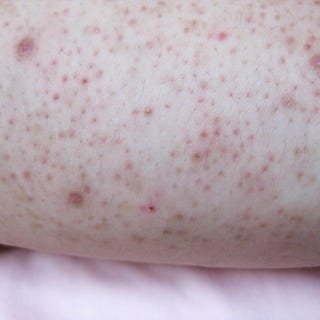Dry Spots On Back
- Yeast on the skin can also cause tinea versicolor, a condition that triggers dry, scaly, discolored patches on areas of high sweat—usually the neck, chest, back, and groin. “Yeast loves moist.
- Seborrheic dermatitis is a skin condition that occurs when the sebaceous glands produce too much oil. It typically causes patches of white, crusty flakes on the scalp, face, chest, and back.
/GettyImages-974936420-fead5d361527463a9df142b66bf9c6c0.jpg)
Dry Spots On Back And Neck
Open sores (which may have oozing or crusted areas) that don’t heal, or that heal and then come back Basal cell cancers are often fragile and might bleed after shaving or after a minor injury. Sometimes people go to the doctor because they have a sore or a cut from shaving that just won’t heal, which turns out to be a basal cell cancer.
This material must not be used for commercial purposes, or in any hospital or medical facility. Failure to comply may result in legal action.
Medically reviewed by Drugs.com. Last updated on Nov 16, 2020.
- Care Notes
- Overview
Dry Brown Spots On Back
WHAT YOU NEED TO KNOW:
What is actinic keratosis (AK)?
AK, also called solar keratosis, is a precancerous skin disease. Precancerous means that it may develop into cancer. AK causes a dry, scaly, or rough bump to form on your skin. AK is found more often in fair-skinned, light-haired people. AK is caused by sun exposure.
What increases my risk for AK?
- Older than 40 years
- Use of tanning beds
- Weakened immune system
- Other skin conditions such as xeroderma pigmentosum or burn scars
What are the signs and symptoms of AK?
AK may occur as a single sore or as many sores of different sizes. Most of these bumps are found on the head, neck, or arms. You may have dry, scaly, or rough skin sores. The sores may be pink, red, brown, or the same color as your skin. Your sores may become hard, crusty, and wartlike. The sores may become itchy or painful. They may bleed when touched.
How is AK diagnosed?
Your healthcare provider will ask about your sores and examine you. Tell your provider what your sore first looked like and when it started. He or she may ask about your sun exposure, medical history, and activities. A biopsy of your skin or sore may show if you have AK.
How is AK treated?
Cryotherapy may be used to freeze bumps or spots with liquid nitrogen. Medicines may also be used on your skin to treat your AK. Take them as directed. Other procedures may be needed. Your healthcare provider may cut, scrape, freeze, or burn a section of skin to remove the AK. Your healthcare provider may recommend chemical peels, dermabrasion, or laser therapy to treat your AK.
How can I protect my skin?
- Check your skin for new bumps once a month. Know what your birthmarks look like. Watch closely for changes.
- Protect your skin:
- Do not use tanning beds. The beds use ultraviolet (UV) rays and can damage your skin as much as the sun.
- Wear sunscreen that has an SPF of 30 or higher. The sunscreen should also have UVA and UVB protection. Follow the directions on the label when you use sunscreen. Put on more sunscreen if you are in the sun for longer than an hour. Reapply sunscreen often if you swim or sweat.
- Stay out of the sun between 10:00 am and 4:00 pm. The sun is strongest and most damaging to your skin between these times.
- Protect your lips by using lipsticks and lip balms that contain sunscreen.
- Wear long-sleeved shirts and pants to protect your arms and legs when you are out in the sun. Wear a hat with a wide brim to protect both your face and neck.
When should I contact my healthcare provider?
- Your skin stings or burns when you use your medicines.
- You have new or worsening symptoms.
- You have pus or blood oozing out of sores.
- You have questions or concerns about your condition or care.
Care Agreement
You have the right to help plan your care. Learn about your health condition and how it may be treated. Discuss treatment options with your healthcare providers to decide what care you want to receive. You always have the right to refuse treatment. The above information is an educational aid only. It is not intended as medical advice for individual conditions or treatments. Talk to your doctor, nurse or pharmacist before following any medical regimen to see if it is safe and effective for you.
© Copyright IBM Corporation 2020 Information is for End User's use only and may not be sold, redistributed or otherwise used for commercial purposes. All illustrations and images included in CareNotes® are the copyrighted property of A.D.A.M., Inc. or IBM Watson Health
Further information
Always consult your healthcare provider to ensure the information displayed on this page applies to your personal circumstances.
Learn more about Actinic Keratosis
Associated drugs
